
CO-04 (Special Election)
See Full Big Line
(R) Greg Lopez
(R) Trisha Calvarese
90%
10%

President (To Win Colorado)
See Full Big Line
(D) Joe Biden*
(R) Donald Trump
80%
20%↓

CO-01 (Denver)
See Full Big Line
(D) Diana DeGette*
90%

CO-02 (Boulder-ish)
See Full Big Line
(D) Joe Neguse*
90%

CO-03 (West & Southern CO)
See Full Big Line
(D) Adam Frisch
(R) Jeff Hurd
(R) Ron Hanks
40%
30%
20%

CO-04 (Northeast-ish Colorado)
See Full Big Line
(R) Lauren Boebert
(R) Deborah Flora
(R) J. Sonnenberg
30%↑
15%↑
10%↓

CO-05 (Colorado Springs)
See Full Big Line
(R) Dave Williams
(R) Jeff Crank
50%↓
50%↑

CO-06 (Aurora)
See Full Big Line
(D) Jason Crow*
90%

CO-07 (Jefferson County)
See Full Big Line
(D) Brittany Pettersen
85%↑

CO-08 (Northern Colo.)
See Full Big Line
(D) Yadira Caraveo
(R) Gabe Evans
(R) Janak Joshi
60%↑
35%↓
30%↑

State Senate Majority
See Full Big Line
DEMOCRATS
REPUBLICANS
80%
20%

State House Majority
See Full Big Line
DEMOCRATS
REPUBLICANS
95%
5%
 June 24, 2021 11:18 AM UTC
June 24, 2021 11:18 AM UTC 15 Comments
15 Comments

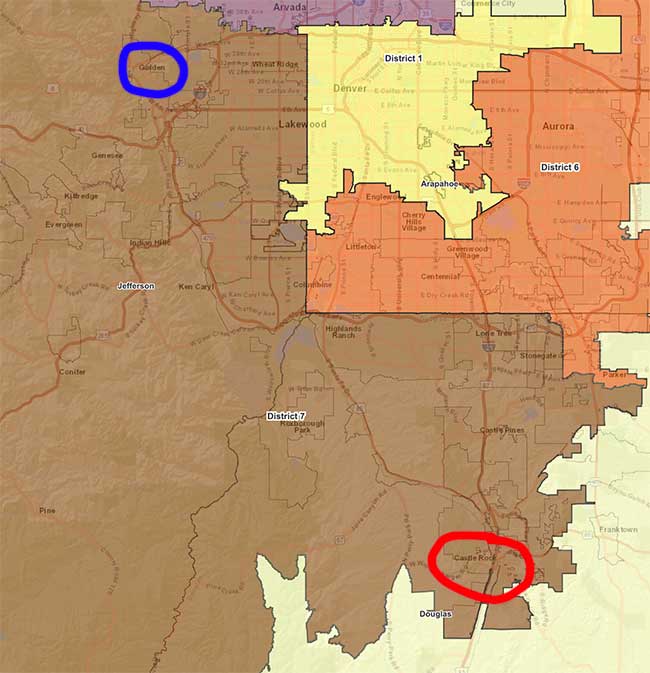
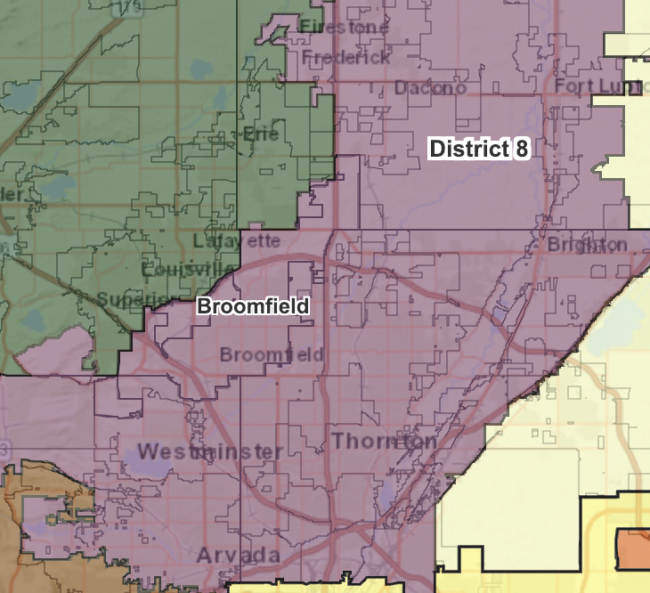
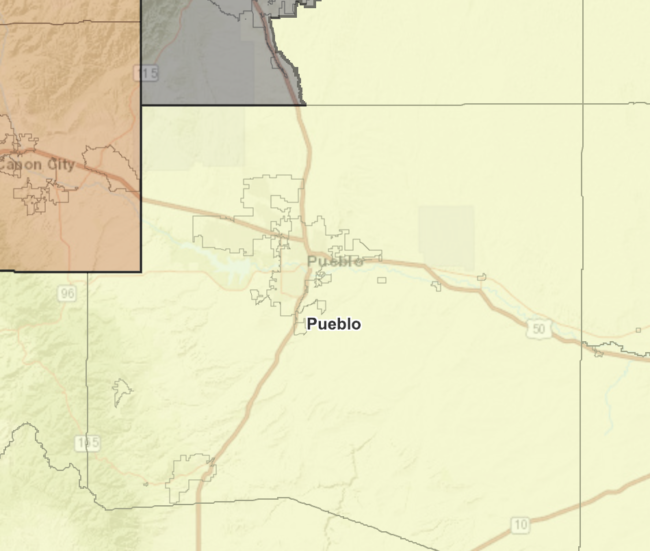
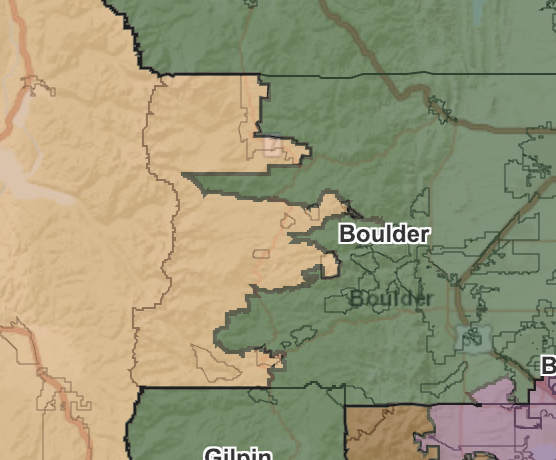
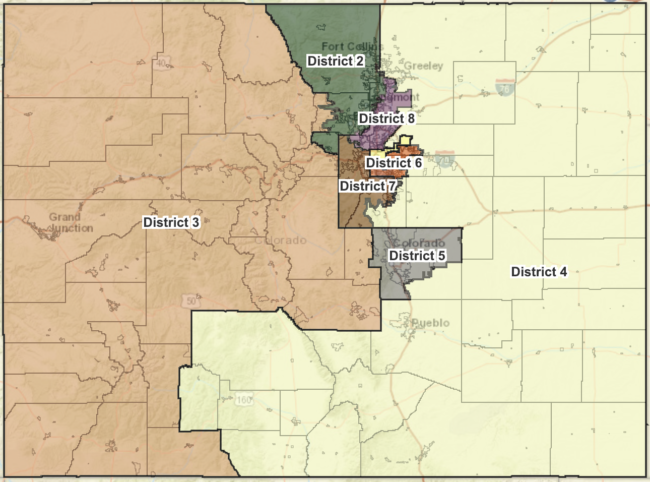
The reason this map favors the GOP is because you cannot possibly draw a map that doesn't. Republicans are spread out and Democrats are compact. So many Democrats are packed into Denver, Boulder County, and Aurora. This results in a 4-4 split that features narrower margins for Republicans than Democrats, because Republicans live in areas that are more politically competitive.
Unless you drew Boulder County or Larimer County into a mountain district, which would be legitimately gerrymandering, you cannot fix this problem. The proposed D7 voted 53-44 for Biden…that make you happy?
Also, you really overestimate how blue Colorado is. You yap about the 13 point margin, but that 13 point margin gave Biden 55% of the vote. That means he's closer to a 4-4 split (50%) than a 5-3 split (62.5%). And that election was obviously an outlier because of a weak GOP candidate – same with the gubernatorial election. The AG election might be a little too Republican, but the SoS and Treasurer elections are a pretty good diagnosis of where the state actually is.
And, it really doesn't matter. If the map was 8-0 Republicans, but the map met all the Constitution criteria, that would be better than forcing a 5-3 split.
Golden and Castle Rock aren't that similar? Aren't they both mountain towns with modest populations, at the edges of the Denver metro area? I do think it's weird that *Lakewood* and Castle Rock are in the same district, or that Dacono is with Arvada, hopefully the second draft manages to fix that. But this map is WAY better than some of the weird crap I saw Democrats propose, like a Southern Colorado district. This takes almost all the comments on communities of interest – like Longmont being in D2, having two rural districts, El Paso being as unied as possible, having a NoCo district, keeping Denver whole, keeping the San Luis Valley whole and with the Pueblo area – and gets as close as you can.
DaCashman … valid points.
But on the House district splits, we aren't going to be looking at state-wide numbers for President. From coverage, in pursuit of "competitive," the staff chose the AG race, the narrowest state contest.
In an ideal world, we'd have a sense of ALL the people, not just the 75% or so of the eligible who voted in 2020. Since I don't think we can do that, the district map needs to hold up to multiple perspectives: state-wide election results, probably county-by-county results, and almost certainly voter registrations (now with state-wide active registrations at about 29% D, 26% R, 2% other parties, 42% unaffiliated).
So completely denying a voice to Democrats in a state Republicans haven’t managed to win in seven years is better than a natural 5-3 split? Who in their right mind would believe this? What are you on? How the fuck do you get off suggesting I shouldn’t get a voice in my own fucking state?
Go storm a fucking capitol building in some other country and get the fuck out of our Republic.
I gotta agree with DaCashman on this one. Looking at it with a wide lens, it's hard to imagine Colorado, without a gerrymander, being anything other than a reasonably solid 4-3 Dem split, with one competitive district. Were the partisans looking for a 6-2 D advantage? You simply cannot do that without a gerrymander of Denver and Boulder.
Also, I have spent a lot of time in both Golden and Castle Rock. They may be politically divergent right now, but they are both full of upwardly mobile professionals (and their kids), many of whom moved from Texas and California. They have a lot more in common which each other than with the rural, mountain, or urban populations of the state.
First thing, there may well be noticeable differences between Census Bureau estimates for July 1, 2019 and the actual Census of April 1, 2020.
Next, this reflects judgment of staff — I have no idea how the 12 people on the commission view it, how people will talk about it at the mandated listening sessions, what an 8 person majority may be able to coalesce on, or, failing finding a majority, what the judicial panel will do.
So, an interesting start to discussion. but not much more.
I do understand the idea that this map is preliminary, but it is a really shitty starting point for any negotiation – Democrats are playing defense at the outset. I would guess that all of the additional population Colorado has gained to attain this extra congressional seat is overwhelmingly D or I, and for that we get a net gain in seats by the Republicans ? How does that even make sense ? No different than voter suppression, or the filibuster – D's are just getting fucked again and are fine with it.
One dudes humble opinion. I really hope this map changes. A lot.
Ed wins this map by 5-8, if he holds on a few more terms this will turn D just like Jeffco.
But yeah, the bigger picture is we start behind and have to play catch up yet again.
Yes, Permutter would be a good candidate for a suburban, moderate-Republican district, especially against a gun-nut, libertarian or Trumpian oponent.
It’s insane that a state with a 4-3 split that is increasingly moving left from there could still end up cramming in another Republican district.
So, while Republicans in other states are trying to legislate the Democratic party out of existence, Democrats here are trying to be fair. I have a couple predictions:
1. In trying to appear fair, the Dems will in fact give at least a slight degree of favor to the GOP.
2. Regardless of the outcome, the GOP will shriek as if the Democrats have come to take away their children.
I have a problem with a republican, a Big Lie supporter, and a known liar, sitting on this commission…there is no way we will see any kind of a normal and fair redistricting with any republican sitting on the commission….
He is an outlier and the rest of the commission generally keeps him in check.
They notably unanimously removed him as chair pretty early on.
Leave it to Dems to give away a hard-fought/won political advantage in the interest of being "fair."
It seems to me that the staff confused a mandate to draw the boundaries of districts without considering partisan objectives with a goal of assuring that each party has the same number of districts. The staff maps also neglect "communities of interest," as others have pointed out. There is just no way that southern Jeffco belongs with DougCo in a district. One is suburban, the other exurban; one is far more diverse (Jeffco) than the other.
A fair and nonpartisan map that recognizes communities of interest should probably result in a 5-3 or even 6-2 divide between districts likely to favor Democrats and those that are likely to favor the GOP, considering the overall shift of voter registration and sentiment in this state.
I think a fairer map would be 4 for sure D (1,2, 6,7) , 2 for sure R (4,5) and two lean districts (the new 8 which would be lean D) and a CO-3 which would lean R.
They could've easily accomplished this by making 8 a southern burbs, DougCo district. Basically the parts of the burbs that used to be in CO-1, some parts of southern JeffCo and then Highlands Ranch, Castle Rock, etc. Let CO-6 wrap around DIA like it did before. And give Fremont to CO-4 and have CO-3 pick up like Gilpin County or Estes Park. If CO-3 was a like R+3-4 district, we could get rid of Boebert, but longterm probably have someone like Scott Tipton which would be fine.